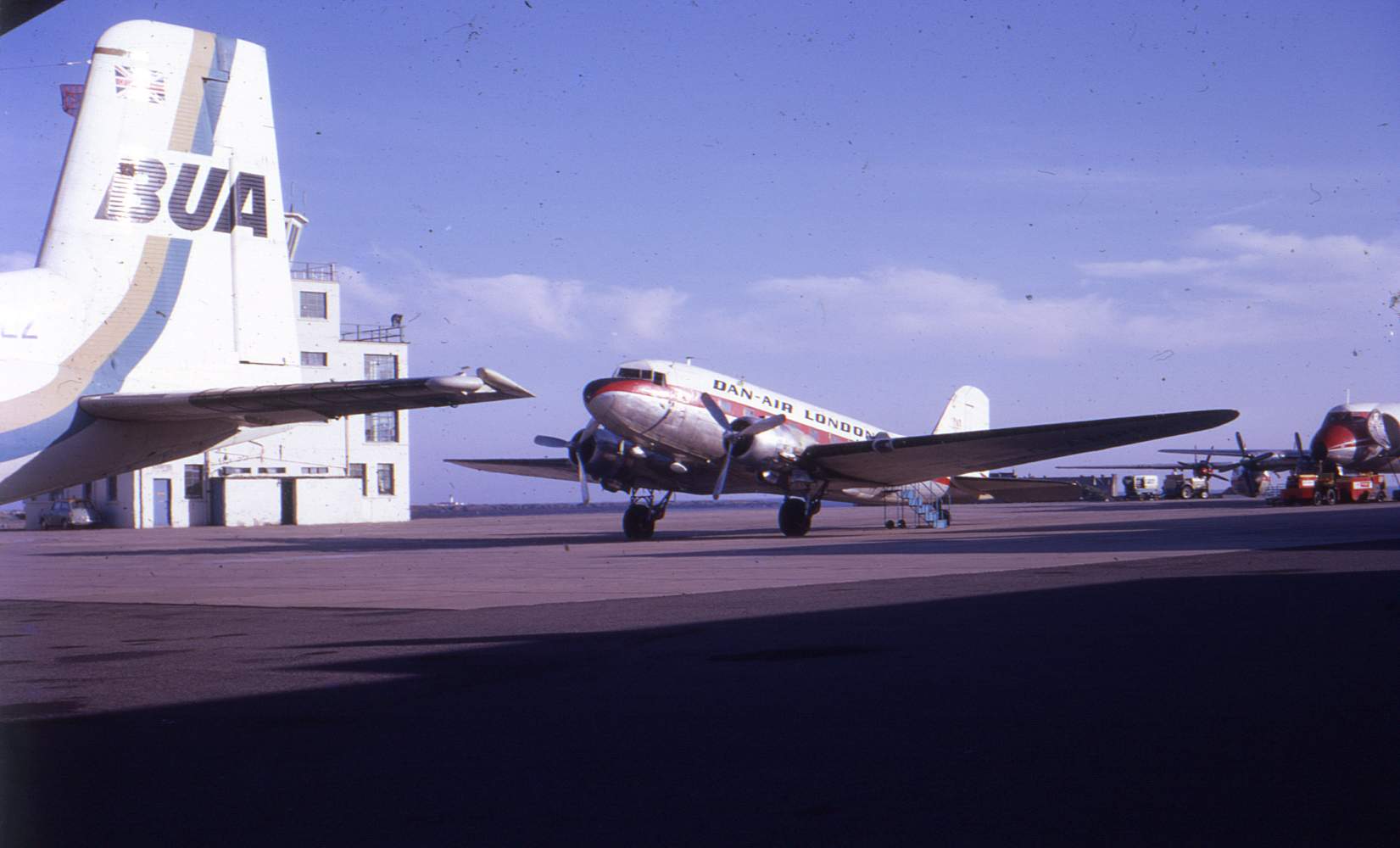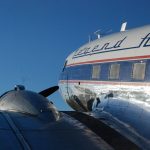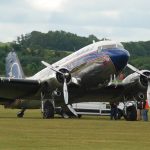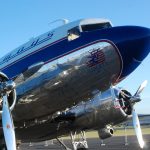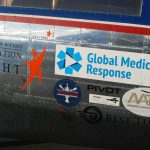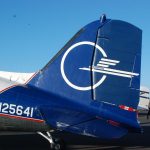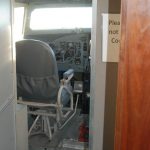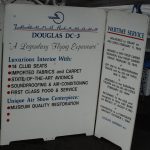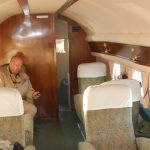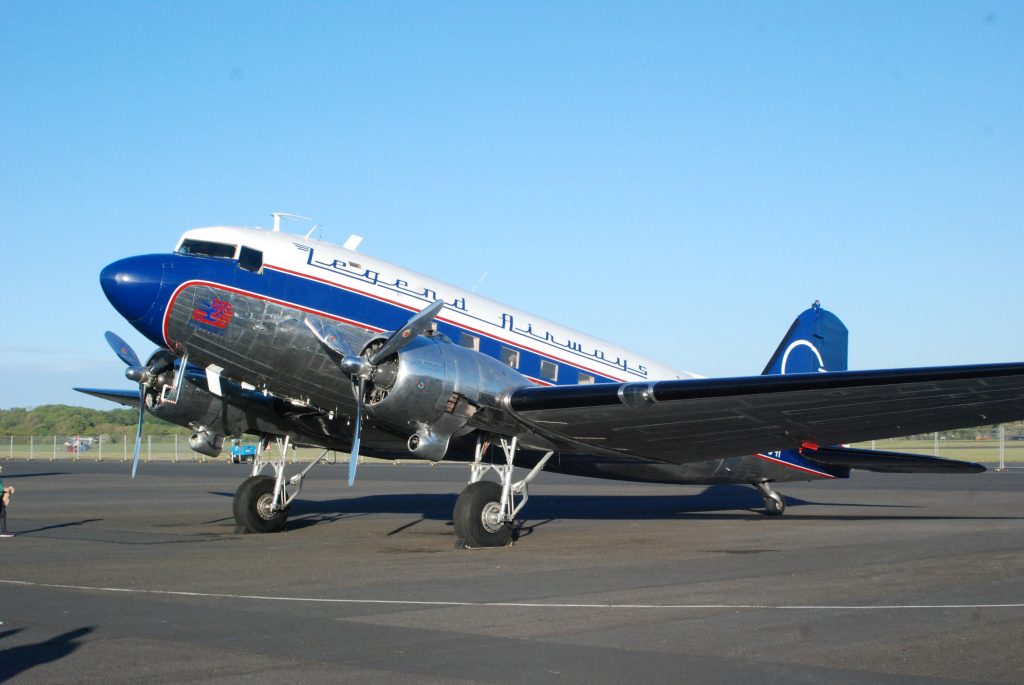
With construction number 9059, Liberty was built at Douglas’s Long Beach factory during 1942/ 43 as part of contract DA-AC-1043 and delivered to the USAAF as 42-32833 on 11th February 1943. She was assigned to the 60th TCS (Troop Carrier Squadron) of 63rd TCG (Troop Carrier Group) on 25th February 1943. The 63rd was originally a home-based unit which had been a transport group up until April 1942 when it was placed under the control of the first iteration of Air Transport Command. When this subsequently became I Troop Carrier Command (the machinations of the early days USAAF are elaborated in the ‘Betsy’ thread), 63rd became a Troop Carrier Group tasked with training personnel on C-47s. In February 1943, 63rd would have been based at Victorville, California, an airfield up in the Mojave desert which, today, is known mainly as a ‘desert boneyard’. In the early 1940s it had just opened as an advanced flying school. On 7th May 1943, 63rd TCG moved base to Lawson Field, Georgia (1) but, three days earlier, Liberty had departed for North Africa to join the 12th Air Force at Oran in Algeria (2).
Liberty’s participation in the 12th Air Force is not known in detail but, if she joined 61st TCG on August 17th 1943, it would have been at Kairouan airfield in Tunisia. By then, the Axis occupation of North Africa was over and Operation Husky had propelled the allies into Sicily. Operations would have covered Sicily, Malta and glider-towing practice near the Tunisian island of El Djerba. As from August 26th, 61st was on the move from Africa to Europe with a new home established at the newly-bull-dozed airstrip in the wheat fields to the north-west of Licata, Sicily. The move was completed around September 5th (3). By the second week in September, the Italian surrender had left the Germans defending the southern sector of Italy against allied forces. The German army was putting up strict resistance and Lt. General Mark Clark’s 5th Army was soon in need of reinforcement. On September 13th 1943, operation Giant 1 was conceived at great speed with a plan to land troops at Agropoli, south of Naples. Forty-one C-47s of 61st TCG flew to Comiso that evening; a battle plan was pasted to the side of a C-47 and, in the headlights of a jeep, the pilots were briefed by Colonel Willis Mitchell. Take-off commenced at 23:20 with 43 aircraft heading north to arrive at the Drop Zone at 01:30 (4). The group was back home without casualty by 03:30. A similar mission was repeated with fewer aircraft the following night, dropping paratroops in the vicinity of Paestum, near Agropoli, again. The Commanding General of 12th Air Force’s Troop carrier command flew along with 61st on this second mission (Giant 4, with a total of 125 C-47s carrying 1900 505th PIR troops). On the following days, further parachute operations were carried-out, gliders were landed near Paestum and supply/ evacuation flights were operated to Taranto in the ‘instep’ of Italy where the British 1st Airborne had landed on 9th./ 10th September. Although German fighter cover was largely absent and there were no combat losses, there were difficulties using the very short and dusty fighter strip at Paestum. Initial landings stirred-up a huge cloud of dust at the end of the runway as aircraft braked to a halt. The first aircraft to land had not been able to move to dispersal before successive aircraft began to land, skidding to a halt in the dust storm that was still stuffed with C-47s.
During late September, freight and troop transport continued with deliveries to mainland Italy and gliders being brought to the Licata base from North Africa. Forward fighter bases were moved northwards by the 61st TCG as the front line advanced. At the end of the month a considerable number of C-47s was allocated for logistical flights between Foch, Tunisia, and Decimomanou, Sardinia.
At the end of the first week of October 1943, the 61st TCG moved from Licate to the former ME109 air base at Sciacca, also in Sicily. The field had a packed-earth runway and basic structures and facilities – during the winter rains it would become insufferably muddy. Logistics flights continued to the Pomigliano air base at Naples, the port of Bari and other intermediate air strips as the allies advanced northwards. Indeed, the 53rd TCS seems to have had a long-term presence at Pomigliano. Other airfields prominent in the logistics runs during November included Comiso, Palermo, Catania and Milo (all on Sicily), tranto, Bari and Foggia. On December 1st, two flights of C-47s from 14th TCS (Liberty’s squadron when she reached the UK) returned to Sciacca from Corsica and Sardinia. This operation, sometimes routed via North Africa, was to become a regular feature for 14th TCS. On December 11th Captain Aubrey Lyon’s aircraft was recorded as being damaged by prop wash from another aircraft while at Palermo. Capt Lyons would be ‘Liberty’s pilot on D-Day but nothing here suggests that he was flying 42-32833 on this occasion. By mid-December, 14th TCS aircraft were operating missions well to the west, to Oran and Casablanca, Morocco, for personnel transfers.
Training with gliders was carried-out in January 1944 as the group awaited the Anzio beach landings. In the event, the allied operation did not include an airborne aspect and regular transport and evacuation work continued for 61st TCG. By February 1944, the 61st was preparing for its move to join 9th Air Force operations in England. Details of the transfer to Barkston Heath appear in the ‘Virginia Ann’ thread.
(1)Information from www.historyofwar.org/air/units/USAAF
(2) From Legend Airways own information board. Air Britain’s History of the DC-3 and its Predecessors, JMG Gradidge, has 43-32833 joining 12th Air Force in Algeria on 17th August 1943, returning to the USA exactly 2 years later on August 17th 1945.
(3) Detailed diary information for 61st TCG operations is taken from the website http://ww2flyers53rdtc.com/TableMembers.html.
(4) Detail from David Isby’s book C-47/ R4D units of the ETO and MTO, published by Osprey. This gives a total of 82 C-47s supplied by 61st TCG and 314th TCG carrying 1300 men of 82nd Airborne’s 504th PIR. The operational diaries for 61st TCG give 43 C-47s.

As described in the section on Virginia Ann, the 61st TCG remained at Barkston Heath throughout 1944 and early 1945 and it was from here that their Normandy and Market Garden operations were launched. While Liberty 42-32833 doesn’t feature in the squadron diary information, she is recorded in taking part in the D-Day operation as Chalk #21, flown by Aubrey G.Lyon as part of Serial 24 (5). During the first hours of June 6th, the thirty-six C-47s of Serial 24 made their way south, crossing the English coast at Portland Bill at 500′. Liberty was aircraft #19, the port C-47 in the seventh 3-ship ‘vee’ of Dakotas. They headed south-west, out to sea, towards the Channel Island of Guernsey. To the north of Guernsey, around fifty nautical miles from Portland Bill, a vessel code-named Hoboken was fitted with a Eureka beacon. Upon reaching Hoboken, the armada of Dakotas turned to port onto a south-easterly course to pass between the German-occupied Channel Islands of Alderney and Guernsey. Heading for the Cotentin Peninsula of Normandy, Virginia Ann, lead ship for 61st, was due to cross the French coast at Flamenville en route to drop zone ‘T’ to the west of St.Mere Eglise. The scheduled arrival time for Liberty’s Serial 24 over DZ ‘T’ was 02:32. Clear skies above the English Channel gave way to early morning banks of fog over the French coast although Liberty’s 14th Troop Carrier Squadron reported a cloud base at 2500′ and scattered cloud at the drop altitude of 7-800′ over the DZ. While the Pathfinders allocated to Drop Zone ‘T’ had landed successfully and been able to initiate the Eureka beacon, the presence of nearby German troops meant that they had been unable to turn-on the red ‘T’ marker lights. The drop order placed the 61st TCG second from last after the 316th TCG (from Cottesmore), 315th TCG (Spanhoe), 314th TCG (Saltby), 313rd TCG (Folkingham) and just ahead of Balderton’s 442nd TCG. The German forces were therefore well aware of the operation by the time 61st arrived over the drop zone. While some 61st aircraft came under a heavy barrage of ground fire, 14th TCG in Serial 24 reported only weak anti aircraft fire (5). The squadron was over the drop zone between 02:29 and 02:37 but cloud at the 7-800′ drop altitude led to a loss of formation and some confusion. Although it was reported that the paratroops were dispatched successfully, a couple of C-47s had to make additional passes and many of the 507th PIR troops landed between their intended location and St Mere Eglise. This was a swampy area with surface water, not ideal for the heavily-laden paratroops, and this accounted for some initial deaths. Of Liberty’s complement of 15 paratroops, one was reported as ‘killed in action’ on D-Day itself, another died of wounds on July 5th and a third was killed in action in Germany the following March.
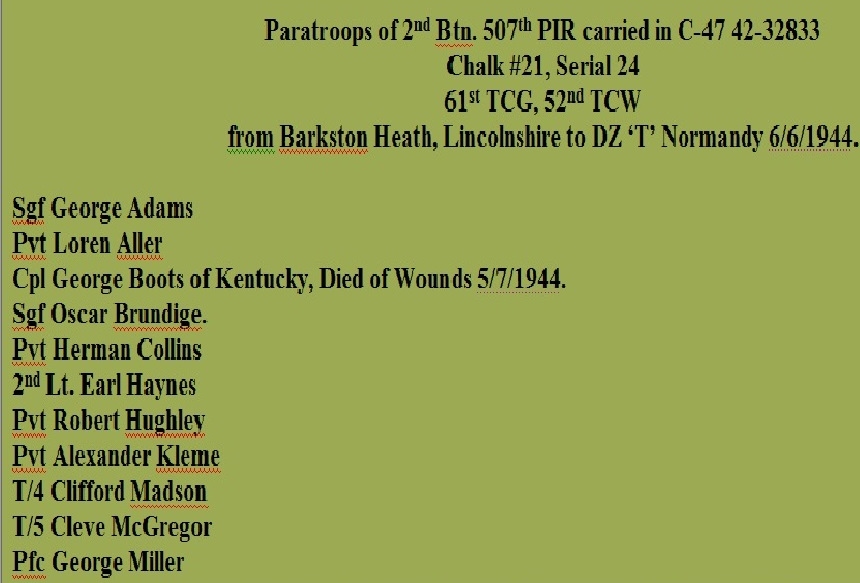
The following day, June 7th, 61st TCG was in action on Mission Freeport, a re-supply operation. 14th TCS was in Serial #38 and departed Barkston Heath at 03:32. The weather was cloudy over England although visibility was reported reasonable by 06:04 when the drop zone was reached. However, formations had not been maintained during periods of instrument flying and there were some delays dropping the supplies owing to load master inexperience. Extensive fighting was going-on beneath the aircraft and, although the 14th TCS reported only ‘weak and accurate machine gun fire’, the approach to the drop zone at 5-600′ altitude and 100-115 knots made the C-47s irresistible targets. 14 TCS was at the tail-end of Serial #38 and five of their twelve aircraft were hit. Nine managed to return to Barkston Heath by 09:15 while one landed early at Pershore, another at Exeter. One is believed to have ditched in the Channel. Of the five aircraft with damage, four required serious attention before flying again. 42-32833 was one with holes in the fuselage and severed wiring recorded as the problem (5) and the present owners cite work orders for the ‘repair of bullet holes’ which probably date from this operation (9).
Little else is seen about 42-32833 until a report dated 1st January 1945 which detailed a taxiing accident at Advanced Landing ground A41, Dreux, in France (6). The pilot is recorded as William H.Smith and 42-32833’s unit is given as 100 Troop Carrier Squadron of 441st Troop Carrier group. There is no record in the 61st TCG war diaries of the aircraft being transferred out of 52nd TCW to 50th TCW (7) but it seems possible that this happened after D-Day. The ‘1/1/45’ date looks a little arbitrary, but 441st had been in residence at Dreux since 3/11/1944 and William H.Smith of Washington State did fly with 100th TCS. The 441st TCG had been based at Merryfield, Somerset, for D-Day operations but transferred south to Grosseto in Italy on 17th July 1944 to support Operation Dragoon, the invasion of Southern France, on August 15th. Returning for a brief stay at Merryfield on 25th August, 100th TCS moved to ALG A-63, Villeneuve, France, on 8th September 1944 (8). The 100th took part in dropping 82nd and 101st Airborne on September 17th during Market Garden followed by glider and re-supply missions on 18th and 23rd. Following moves to St. Marceau and, subsequently, Dreux, 441st were involved in supplying Bastogne during the Battle of the Bulge and Operation Varsity, the Rhine Crossing. During the latter, 441st TCG towed gliders, which had become a speciality. In particular, they were known for using their C-47s to recover gliders from landing grounds using the ‘airborne snatch’ method and had been involved in assembling a force of around 200 gliders prior to Market Garden operations.
(5) From 14th TCS Mission reports authored by Intelligence Officer Capt Arnold Newman.
(6) www.aviationarchaeology.com
(7) In December 1944 61st TCG had 95 aircraft and 600 pilots, so many didn’t get mentioned frequently in the various squadron diaries. 833’s regular pilot, Aubrey G.Lyon, returned to the USA on 27/11/1944 but remained with the air force, eventually retiring as a Lt.Colonel with Air Force Logistics Command. He died in 2004 in Mesa, Arizona.
(8) www.USAAF.com/9AF/441troop
(9) Legend Airways aircraft history.
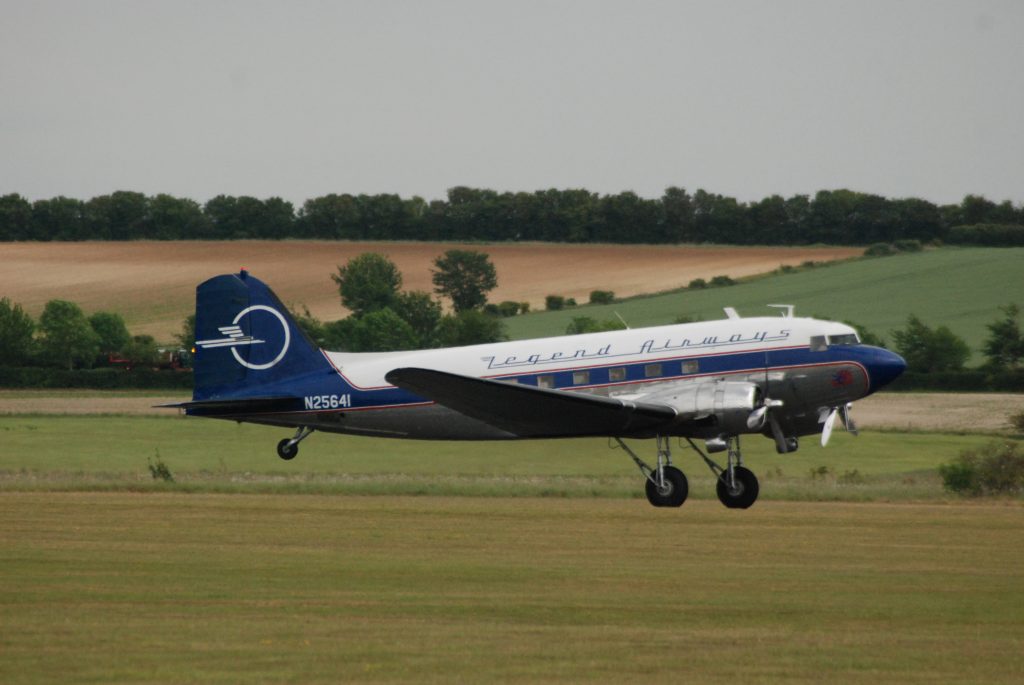
42-32833’s war was over by the summer of 1945 and she is recorded as returning to Greenville in the USA on 17th August 1945, exactly 2 years (and a great deal of action) after setting-out for North Africa. Initially with the 121st AAF Base unit at Bradley, Connecticut (9), ‘833 is recorded as being with the Reconstruction Finance Corporation by November 6th 1945. Switching her military ID for a brand new civilian registration, NC25641, Liberty was bought in the name of Reginald J.Robbins of Houston, Texas on 1st October 1946 and registered 20 days later. The next recorded owner was Texas Eastern Transmission Corporation, a company incorporated in January 1947 specifically to bid for government-owned pipelines which were being de-mobbed in the same way as the USAAF C-47s. Texas Eastern bought ‘The Big Inch’ and ‘Little Big Inch’ pipelines which delivered oil and oil products from the Texas oilfields to the industrial east coast of the USA and were now thought to be suitable for gas transmission (10). NC25641 was delivered on 8th September 1948 and operated for over 20 years from the company’s Shreveport, Louisiana base. The civilian register had shortened the ‘NC’ category to just ‘N’ by the renewal of Liberty’s Certificate of Airworthiness on 15/3/1956. A further CofA is recorded as being issued on 21/4/1970 and, in September of that year, N25641 was sold to Page Airways of Rochester, New York. Page had been established in 1939 by James Wilmot (a construction magnate) and Elmer Page (a pilot) with Page Airways and Wilmorite Construction both registered in Rochester. Although the company did run some domestic flights in the 1940s between locations in Florida, New York and Washington and offered some charter capacity, a lot of their business was linked with large infrastructure projects. By 1982 they were reported (11) to be doing over $100 million worth of business with government agencies. While much of this contract work revolved around the provision of non-commercial aviation facilities such as fuel supply at US airports, they were also linked to Southern Air Transport, reputedly a CIA-financed airline, in 1975. Page had become agents for Grumman’s Gulfstream II in 1970 and, at one stage, were reported to have ambitions to purchase Grumman in a joint-venture with Saudi Arabian companies (12). As N25641 was likely to have been a corporate aircraft for Texas Eastern Transmission Corporation, the move to Page could have been a trade-in against a Gulfstream. Indeed, Texas Eastern did own Gulfstream II N209T from April 1966 until its sale to Royale Airlines in August 1984, but there is no indication that the DC-3 became any form of part-payment. Incidentally, it was Page Airways Gulfstream dealings which got the company into hot water in 1978 when it became the first US company to be charged under new anti-corruption laws (12). Page were accused of making $2.5 million bribes to achieve sales and of routing deals via a Lebanese ‘fixer’ to middle eastern and African customers. They were reported to have sold corporate jets to Libya’s Colonel Qaddafi and Ugandan tyrant Idi Amin via a Zurich-based intermediary, Zimex Aviation (allegedly owned by Israel’s Mossad intelligence organisation). It seems that the potential links between Page and the CIA on these deals and the Southern Air Transport work might have been sufficient for the court case to be quietly settled in 1980. By then, N25641 had moved on to new owners.
(10)https://legacy.lib.utexas.edu/taro/ricewrc/00177/rice-00177p2.html
(11) From ‘The Nation’ 20/2/1982.
(12) Various reports from NY Times, www.wiandlaw.com and www.cia.com.
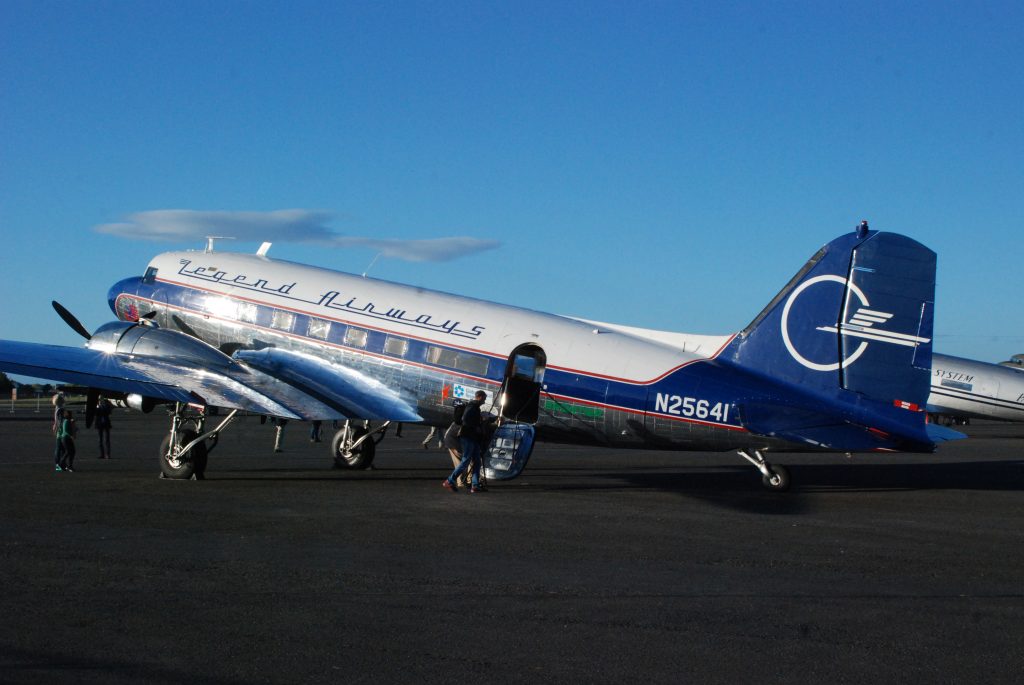
Page Airways transferred Liberty to the Dee Howard Company of San Antonio, Texas on 22nd April 1971. Durrell (Dee) Howard had established his engineering company in San Antonio in 1964 to concentrate on upgrades and improvements for business/ corporate aircraft. He had previously formed the Howard Aero Company in 1947 to re-manufacture Lockheed Lodestars and Venturas into executive transports. The company had sourced aircraft from the USAF and South African Air Force and, by 1960, was employing around 1000 making it San Antonio’s largest manufacturing company. One Howard 350, N593EW, was registered to R.H.Bentley between 1/4/1969 and 16/5/1969 and this same owner is also recorded as taking delivery of N25641 on 26th April 1971. However, by May 21st of the same year, Liberty had moved on to MJA Schekaiban in Mexico (13). the owner is likely to be Miguel Jose Abed Schekaiban, a Mexican aviation entrepreneur of Lebanese descent who ran an air taxi business with his younger brother. The latter, Alberto Abed Schekaiban, went on to operate the low-cost airline TAESA in the 1980s and 90s and, subsequently, Vuelamex (Flymexico). By 17th August 1973, Liberty was back in the USA with Dee Howard, possibly for maintenance and upgrade work, possibly for onward sale only.
(13) Air Britain Publications, The Douglas DC-3 and its predecessors, JMG Gradidge, 1984 and also Ruud Leeuw’s website.
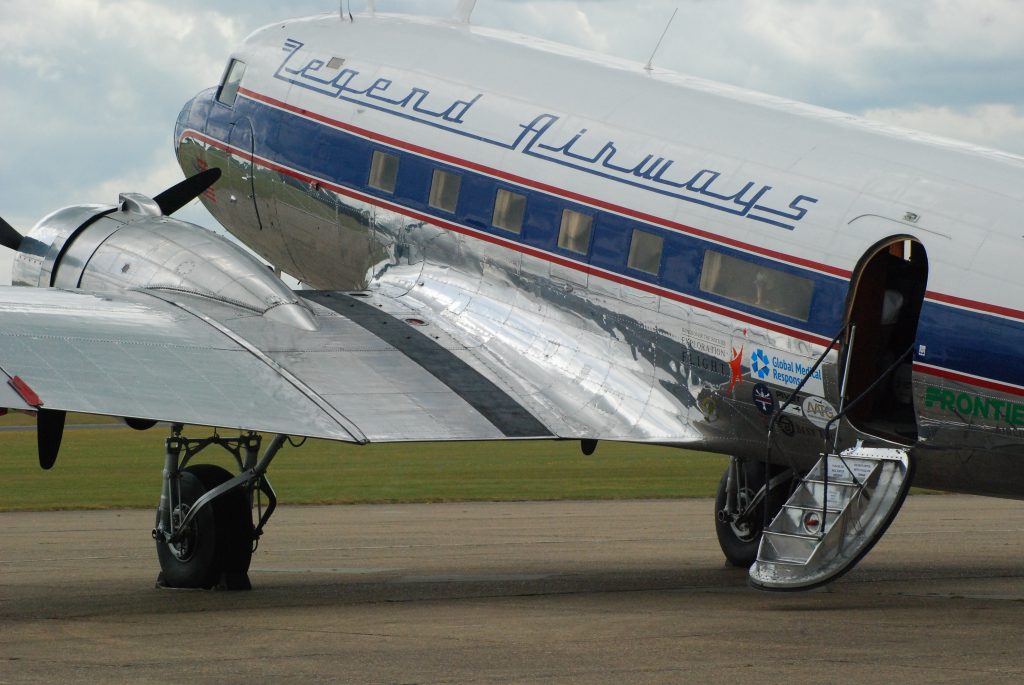
Wells Aircraft, based at the small municipal airport of Hutchinson, Kansas, are recorded as taking delivery on the same day that the aircraft returned to Dee Howard, August 17th 1973. They may also have been involved in service and sales as the next owner, Kearney and Trecker, are recorded as acquiring Liberty on 5th October 1973. N25641 was registered to K&T at their Milwaukee base on 28th December 1973. The company was one of the World’s biggest producers of milling machinery at that time but had also developed aviation interests in the past. They leased two hangers at Milwaukee’s Billy Mitchell airfield and had operated executive DC-3s since the late fifties (14). They operated Liberty for many years but, by 1983, their fortunes were waning. Merging with Cross & Company, they were eventually bought by the Thyssen Corporation in 1997. N25641 was sold in 1983 with Basler Flight services recorded as its new owner on November 16th of that year. In those days Warren Basler was operating his company from Oshkosh Regional Airport as a Fixed Base Operator (FBO) providing passenger and cargo charter services. Formed as far back as 1957, the company was, by 1983, on the cusp of commencing its famous Basler BT-67 C-47 conversion programme. Basler had purchased a pair of turboprop-engined DC-3s to supplement their fleet which, by the DC-3s 70th anniversary on December 17th 1985, already comprised 15 Dakotas within the 25-strong fleet. Warren Basler had seen the market for upgrades to ageing DC-3s and his purchase of the Turbo Threes from Harold Esmailka’s Alaskan air taxi outfit further convinced him that it was a commercial proposition. N25641 had been acquired at this juncture and, registered to the company in February 1984, served Basler for some years. Appearing at Expo 1986 in Vancouver, she formed part of the 24-strong ‘Airmada’ at Abbotsford Airport in June of that year. Liberty sported a very smart colour scheme at the Expo although, unfortunately, it served to accentuate the rather ugly modified nosecone which had been fitted to accommodate upgraded radar facilities.
(14) from www.all-aero.com. Kearney & Trecker also operated a Viscount in the 1980s. It was sold in 1984 when the Aviation Wing was wound-up.
On October 6th 1988 N25641 passed to Dexter D.Coffin Jr, a New England industrialist who split his time between Winter Harbor, Maine and Palm Beach, Florida. The family, Dexter Corporation, had been established by direct descendants of Nantucket Island settlers and had diverse interests centred on paper production – indeed, they brought the porous tea bag to the market. Dexter Drake Coffin Jr was a keen aviator and had served with Ferry Command during WW2, while his father, D D Coffin Sr, had been instrumental in building Hartley, Connecticut’s airport at Bradley Field. In May 1969 Junior bought the last of Johnson Flying Services Ford 4AT Tri Motors and subsequently donated it to the Naval Air Museum in 1973. During the eighties he owned a Cessna 500 Citation, a Sabreliner 75A and a Gulfstream in addition to the DC-3. N25641 was probably used for the commute between Maine and Florida and sported a blue, white and gold colour scheme. It seems likely that she was based at Palm Beach County Airport at Lantana in Florida where she was photographed by Keith Burton in February 1982 (below). A few months later, in June 1992, Liberty was purchased by Erik Fleming and moved on to the Fleming Corporation of Nashua, New Hampshire. Erik Fleming’s company specialised in aviation services and real estate development and Legend Airways was his private project to promote aviation history. N26541 was returned to Basler at Oshkosh in early 1993 for a major upgrade, reputed to be in the region of $2 million. The investment was prompted by Liberty’s low total flying hours of 18,500 and took until 1995 to complete. Indeed, with state-of-the-art instrumentation, modern electronics and air conditioning, Liberty could now be considered to be one of the World’s most sophisticated DC-3s. The Legend Airways site lists carpet woven to order in Spain, cotton head-lining custom-made in France and fourteen comfortable armchair-style seats upholstered in Italian fabric. The acoustics and sound proofing have, similarly, been revised to modern standards which must have made Liberty’s Atlantic crossing one of the most comfortable experienced by the D-Day Squadron (15).
(15) While work was done by Basler in 1993/ 94, other sources suggest that the major upgrade was in 2006. Legend’s own site says 1993 to 1995.
N25641 was officially registered to Legend Airways of Nashua, New Hampshire on 13th January 1999 (16) and has remained with various incarnations of legend ever since. The company Legend Airways of Colorado LLC was formed on 13th July 1999 with a registered base of Morrison, Colorado. Jack Rickard of Cape Giradeau, Missouri was by now behind the venture and had also formed ‘Jack Air LLC’ at Morrison on May 7th 1999. His past operations had included an online information magazine called Boardwatch Magazine which had been directed at Internet Service Providers. He had sold his majority interest in 1998, so clearly had some capital for new ventures. N25641 was registered at Morrison on 23rd September 2000 (16) and was joined by N341A, another D-Day Squadron participant in 2007. On 26th July 2010 both aircraft took part in The EAA ‘Airventure’ Day at Oshkosh, Wisconsin – familiar territory for ‘Liberty’. They were captured by Trev Morson of www.douglasdc3.com parked together on the grass (below).
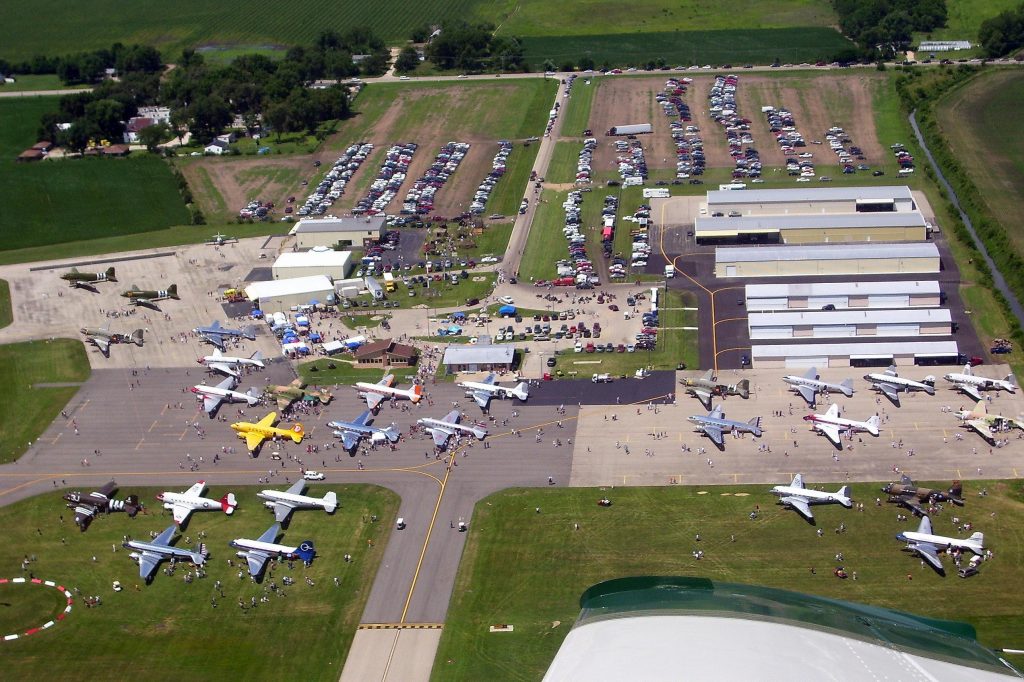
It would seem that the amount of flying carried-out in subsequent years dropped-off dramatically and a 2017/ 18 advertisement with Aerometal International offered N25641 for sale with the comment that it had been hangared but not flown for six years. About the same time, N341A moved on to Aerotechnics Aviation Inc while Liberty was registered on 3/3/2017, again to Legend Airways of Colorado but, this time, at Jack Rickards home base of Cape Giradeau where he was developing an electric car business. Most recently, N25641 was registered to Brandon Jowett’s JB Air services of Brighton, Colorado although she retains Legend titles and appears to be the mainstay of the Legend Airways Foundation. Mr Jowett is himself a Frontier Airlines pilot of over 20 years standing and regularly flies Liberty.
(16) www.aerovisuals.ca. Some sites say 13th February.
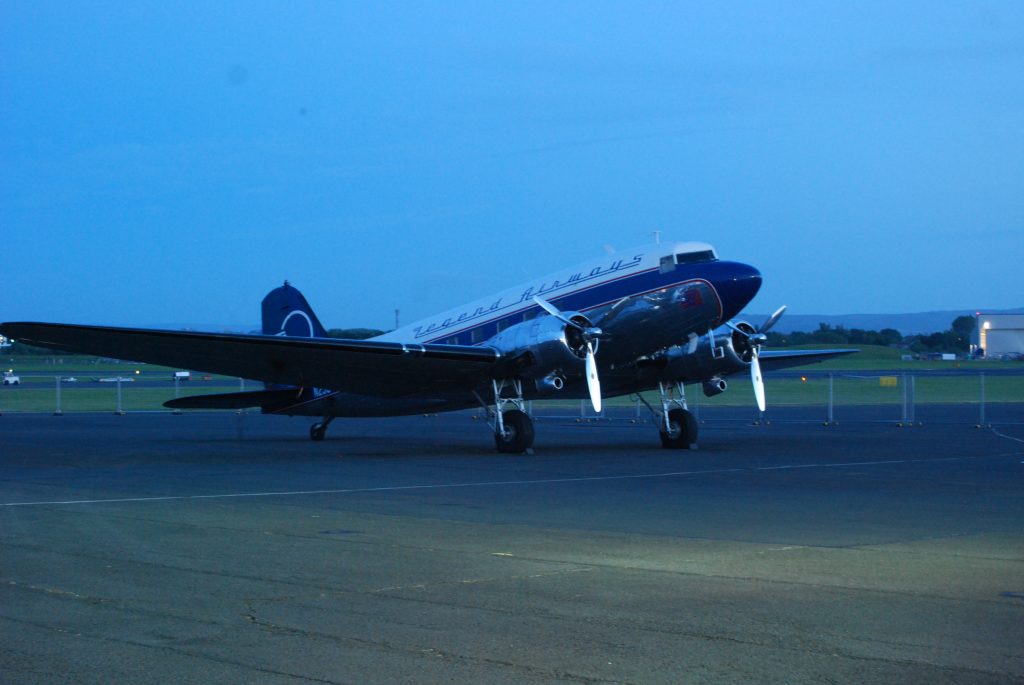
Legend Airways Liberty’s journey with D-Day Squadron:
N25641 was at Denver’s Centennial Airport on 11th May before commencing her journey east to rendezvous with the other C-47s at Oxford, Connecticut. I’ve seen references to a call at Cozad, Nebraska, on 15th May but she certainly had to call-in to the Iowa City airfield on that day when persistent backfiring of the port engine was experienced. This delay meant that she was at Oxford on 18th May ready for departure on the Blue Spruce Route the following day. The first port of call was Presque Isle, Maine, followed by Goose Bay which was reached on 19th May. The following day involved over nine and a half hours flying time to Narsarsuaq and onwards to Reykjavik where she arrived at 21:35. The long over-sea flight to Prestwick was made on 22nd May with her arrival on Scottish soil at 17:35 BST.
The evening of May 24th was an open evening for photographers at Prestwick and the following day was also an open day. I think she departed after the show on 25th May; I heard at least one set of twin wasps above the Ayrshire cloud. Following her arrival at Duxford, she took part in a photo shoot over the White Cliffs of Dover with Miss Montana and the Pan Am DC-3 on May 31st and was at Duxford for the open days from June 3rd to 5th. On June 5th, she departed with the rest of the Squadron for Caen Carpiquet and the D-Day commemoration. The next stop was Wiesbaden air base in Germany which was reached after departing Caen on June 9th. The air display in Germany went very successfully, as did the return across the Atlantic to the USA. She was back in the States on June 20th.
Hits: 1267
